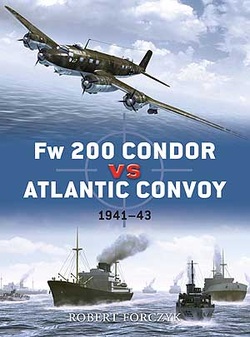
Typically to Duel series there is chronology and two minibiographies, that of Edgar Petersen, quite self-evident choice and that of Eric Brown, the very famous test pilot, maybe not so self-evident choice but Brown was one of the Martlet pilots on the Royal Navy’s first escort carrier HMS Audacity whole of its short career and claimed two Fw 200 Condors. And the arrival of escort carriers was really the turning point in the Fw 200 Condors vs Atlantic convoys battle.
Forczyk is more in home with Condor than with Royal Navy's weapon systems. Contrary what Forczyk writes, 12pdr(3”) wasn’t the main heavy AA gun of Royal Navy in 30s, 4” was and at the end of decade 4.5” dual purpose gun had entered in service. 12pdr might be the most common heavy AA gun installed onto merchant vessels during the WWII but that is a different thing. And the rate of fire wasn’t the main problem of 2pdr pom-pom besides the unreliability of early versions, it wasn’t significantly lower than that of excellent 40mm Bofors, but the fairly low muzzle velocity of the pom-pom was.
The Royal Navy had begun to understand the need for anti-aircraft protection of Great Britain’s merchant shipping by late 30s and sloops constructed in late 30s had powerful AA armament. Bittern-class sloops, 2 of the 3 ships had six 4" AA guns (3x2), HACS AA fire control director, four .5" AA guns (1x4) and Egret-class sloops, 3 ships, 8 x 4-inch AA guns (4x2), Fuze Keeping Clock AA fire control system, 4 x .5-inch AA (1x4) were commissioned 1936 – 39 and just nearing completion were first of the Black Swans, 12 were launched between 1939 and 1943, including four for the Royal Indian Navy; twenty-five Modified Black Swans were launched between 1942 and 1945, including two for the Royal Indian Navy. Their armament was 6 × QF 4 in (102 mm) Mk XVI AA guns (3 × 2), Fuze Keeping Clock AA fire control system, 4 × 2pdr AA pom-pom plus 4 × 0.5-inch (12.7 mm) AA machine guns (original), 12 × 20 mm Oerlikon AA (6 × 2) (modified). The first of Black Swans was commissioned on 3 November 1939 and the second on 27 January 1940 and 3 more during the first part of 41, i.e. at the height of the Condor menace.
Also there were the Hunts of which 19 were commissioned in 1940. They were modeled on the 1938 escort sloop Bittern. The Hunt class was to ship the same armament of three twin Mark XIX mounts for the QF 4-inch (102 mm) gun Mark XVI. The guns were controlled by a Fuze Keeping Clock AA fire control computer when engaging aircraft plus a quadruple QF 2 pounder mount Mark VII. While sloops were restricted to speeds under 20knots by a treaty Hunts were small destroyers with top speed of 27 knots (50 km/h). The first twenty were ordered in March and April 1939. They were constructed to Admiralty standards, as were contemporary destroyers, unlike the frigates which conformed much more to mercantile practice. The demanding specifications in an overworked Admiralty design department resulted in a major design miscalculation. When the detailed calculations were done the centre of gravity was lower than expected and the beam was increased. As the first ships were being completed it was found that the design was as much as 70 tons overweight, top heavy, leaving them dangerously deficient in stability. The first twenty ships were so far advanced in construction that it was necessary to remove the 'X' 4 inch mount and add 50 tons of permanent ballast. These ships became the Type I group, and had the multiple 2 pounder gun relocated from behind the funnel to the more advantageous 'X' position. The design deficiency of the Type I was rectified by splitting the hulls lengthwise and adding a 2½ foot section, increasing the beam and the margin of stability sufficiently for the designed armament to be shipped. These ships became the Type II group. Under the 1939 Emergency War Programme 36 more Hunts had been ordered: three of these were completed to the original (Type I) design.
The main problem for the RN was that the unexpected collapse of France and occupation of Norway by Germany not only opened opportunity for Condors to attack against southern convoy routes but also allowed medium-bomber anti-shipping attacks in Irish Sea and in the waters around Ireland, so these ships were urgently needed besides the North Sea also in this new danger area.
Analyze seems otherwise good, but near the end the 20mm Oerlikon fixation goes to annoying dimensions. Even after Forczyk has told that the more powerful anti-aircraft protection of convoys had forced KG 40 to abandon the low-level attacks and with the new Fw 200C-4 version, which was equipped with the good Lofte 7B bombsight, it began to bomb from 3,000m (10,000ft) to avoid light automatic AA fire, he still regard the number of Oerlikons as measurement of how good AA defense a convoy had.
Another small error in the book is that the first escort carrier with a hangar deck wasn’t HMS Biter but both HMS Archer and HMS Avenger had begun to escort convoys already during the spring 1942.
In spite of some errors the book is a good introduction to Fw 200 Condor and its use as maritime bomber and reconnaissance bomber and the Allied efforts to combat this menace.
 RSS Feed
RSS Feed
